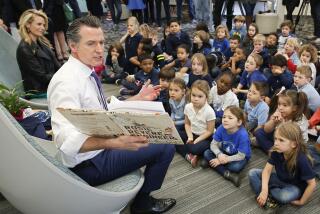Margaret B. Rawson, 102; Pioneer in Study of Dyslexia
- Share via
Margaret Byrd Rawson, a teacher and librarian who helped generations of young people overcome dyslexia, died Sunday at her home near Frederick, Md. She was 102.
Since the mid-1930s, when Rawson taught at a private school near Philadelphia, she had campaigned tirelessly for greater understanding of dyslexia, a neurological disorder that causes difficulty in reading.
Frustrated at her inability to teach a bright second-grader, Rawson discovered the work of Samuel T. Orton, a neurologist who was the first in the United States to identify dyslexia and trace its origin.
Testing the boy, Orton recognized the signs of what came to be known as dyslexia. Orton returned him with a set of instructions--now called the Orton-Gilligham method--on how to help overcome his reading difficulties.
The boy was soon reading at grade level, and Rawson was launched on a lifelong mission. It was often a lonely one, in which she encountered misunderstanding and, sometimes, hostility.
Rawson conducted one of the nation’s longest-running studies of children with language disorders, tracing for more than half a century the lives of 56 boys from The School in Rose Valley, in Moylan, Pa. Until Rawson’s death, many of her “boys”--now mostly in their 70s--kept in close touch. Most went on to successful careers.
“That type of research had never been done before, and it probably will never be done again,” said Roger Saunders, a Baltimore clinical psychologist who worked with Rawson for 44 years. (The Rawson-Saunders School in Austin, Texas, is named for the two.)
Rawson was a founder and former president of the Orton Dyslexia Society, now the International Dyslexia Assn., based in Towson, Md.
“She had an intellect that was palpable, but she was unassuming,” said J. Thomas Viall, executive director of the 13,500-member group. “She was the conscience of the learning-disabled community. Without her, there would be no International Dyslexia Assn.”
Rawson was born in Rome, Ga., in 1899, and raised in Philadelphia, where she attended Quaker schools. She graduated with high honors from Swarthmore College in 1923, the same year she married Arthur Joy Rawson, an engineer.
Rawson and her husband were among the parents who started The School in Rose Valley in 1929, and the couple moved to Frederick in 1946. She taught sociology at Hood College, and developed a seminar on dyslexia, its diagnosis and appropriate remedial teaching strategies.
While teaching, Rawson continued to tutor and work as a clinical psychologist at two Frederick County health clinics.
She earned a master’s degree in social work from the University of Pennsylvania in 1940, and honorary degrees from Swarthmore in 1983 and Hood in 1989. The dyslexia association, on Rawson’s 100th birthday, gave her a lifetime achievement award.
“I’ve had the unique opportunity to see how lives came out,” Rawson said when she turned 100. “These students had all shades of ability and intelligence. Many of them had trouble with language, but with the proper help, most of them succeeded. That’s something to look back on.”
Rawson’s husband died in 1963. She is survived by a son, Kenneth Rawson; six grandchildren; and 13 great-grandchildren. Another son, Edward Rawson, died in 1986.






